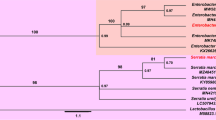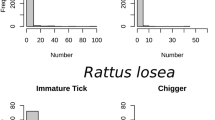Abstract
We surveyed the parasitoid complex associated with four non-pest tephritid flies in Hawaii,Procecidochares alani Steyskal (on the Island of Hawaii), andEutreta xanthochaeta Aldrich,Phaeogramma lortnocoibon Asquith, andTrupanea dubautiae (Byran) (on the island of Kauai). The former two tephritids are deliberatelyintroduced biological control agents of weeds; and the latter two are endemic to the Hawaiian Islands. Ten species of hymenopterous parasitoids in six families were recovered from these four non-pest tephritids. Among these species of parasitoids, six were inadvertently introduced to Hawaii, includingEurytoma tephritidis Fullaway (Eurytomidae),Bracon terryi (Bridwell) (Braconidae),Habrocytus elevatus (Walker) (Pteromalidae),Euderus metallicus (Ashmead) (Eulophidae),Torymus advenus (Osten Sacken) (Torymidae), andEupelmus allynii (French) (Eupelmidae); and three were purposely introduced to Hawaii for classical biological control of economically important pests, includingEupelmus cushmani (Crawford),Diachasmimorpha tryoni (Cameron), (Braconidae), andDiachasmimorpha longicaudata (Ashmead). The relative abundance of parasitoid species and percent parasitism varied with the tephritid hosts. Our findings indicate that future development and implementation of biological control programs against frugivorous tephritids or other pests should consider the potential impact of some of the parasitoids on deliberately-introduced weed control agents. Before we can fully assess the potential impacts of some of the purposely-introduced parasitoids on non-target tephritids, however, effects of the many vagrant parasitoids associated with the non-targets should be thoroughly investigated
Résumé
La présente étude porte sur le complexe de parasitoïdes associés à 4 mouches téphritides non considérées comme des ravageurs à Hawaii :Procedicochares alani Steyskal (sur l’île d’Hawaï),Eutreta xanthochaeta Aldrich,Phaeogramma lortnocoibon Asquith etTmpanea dubautiae (Byran) (sur l’île de Kauai). Les deux premières ont été délibérément introduites comme agents de lutte biologique contre des mauvaises herbes ; les deux dernières sont endémiques aux îles Hawaï. Dix espèces d’hyménoptères parasitoïdes, appartenant à six familles, ont été obtenues à partir de ces quatres espèces de téphritides. Parmi ces parasitoïdes, six ont été introduits accidentellement à Hawaï, à savoirEurytoma iephritidis Fullaway (Eurytomidae),Bracon terryi (Bridwell) (Braconidae),Habrocytus elevatus (Walker) (Pteromalidae),Euderus metallicus (Ashmead) (Eulophidae),Torymus advenus (Osten Sacken) (Torymidae) etEupelmus allynii (French) (Eupelmidae) ; trois ont été introduits délibérément à Hawaii dans le cadre de programmes de lutte biologique classique contre des ravageurs d’importance économique, qui sontEupelmus cushmani (Crawford),Diachasmimorpha tryoni (Cameron), (Braconidae) etDiachasmimorpha longicaudata (Ashmead). L’abondance relative de ces parasitoïdes et le pourcentage de parasitisme varient en fonction du téphritide hôte. Nos résultats indiquent que le développement futur et la mise en place de programmes de lutte biologique contre des téphritides nuisibles aux fruits ou contre d’autres ravageurs devraient prendre en compte l’impact possible de certains de ces parasitoïdes sur des agents de lutte biologique délibérément introduits contre des mauvaises herbes. Avant que nous ne puissions pleinement évaluer l’impact potentiel de ces parasitoïdes introduits délibérément sur des espèces de téphritides qui ne constituaient pas la cible de ces introductions, les effets des nombreux parasitoïdes erratiques associés à ces mouches des fruits devront être complètement étudiés
Similar content being viewed by others
References
Analytical Software. - 1994. Statistix, version 4.1. Analytical Software, Tallahassee, FI.
Asquith, A., Seiler, S., Miramontes, E. & Messing, R. H. - 1997. Taxonomic description and conservation status of a gall forming tephritid fly from the Hawaiian Islands (Diptera: Tephritidae).Proc. Haw. Entomol. Soc. (in press).
Baranowski, R., Glenn, H. &Sivinski, J. - 1993. Biological control of the Caribbean fruit fly,Anastrepha suspensa (Loew).Fla Entomol., 76, 245–250.
Bess, H. A. - 1950. Notes on parasites of tephritid flies.Proc. Haw. Entomol. Soc., 14, 26.
Bess, H. A. &Haramoto, F. H. - 1959. Biological control of pamakani,Eupatorium adenophorum, in Hawaii by a tephritid gall fly,Procecidochares utilis. 2. Population studies of the weed, fly, and the parasites of the fly.Ecology, 40, 244–249.
Bess, H. A. &Haramoto, F. H. - 1972. Biological control of pamakani,Eupatorium adenophorum, in Hawaii by a tephritid gall fly,Procecidochares utilis. 3. Status of the weed, fly and parasites of the fly in 1966-1971 versus 1950-1957.Proc. Haw. Entomol. Soc., 21, 165–178.
Bess, H.A., van den Bosch R. &Haramoto, F. H. - 1961. Fruit fly parasites and their activities in Hawaii.Proc Hawaii. Entomol. Soc., 17, 367–378.
Beardsley, J. W. - 1972. Notes and exhibitions -Habrocytus sp.Proc Haw. Entomol. Soc., 14, 143.
Burns, R. E., Diaz, J. D., andHoller, T. C. - 1996. Inundative release of the parasitoidDiachasmimorpha longicaudata for the control of the Caribbean fruit fly,Anastrepha suspensa. In: Fruit Fly Pests: A World Assessment of Their Biology and Management.(B. A. McPheron &G. J. Steck, Eds.) -St. Lucie Press, Florida, 377–381.
Clancy, D. W. - 1950. Notes on parasites of tephritid flies.Proc Hawaii Entomol. Soc., 14, 25–26.
Clausen, C. P. - 1978. Introduced parasites and predators of arthropod pests and weeds: a world reviews.U.S. Department of Agricultural Handbook, 480, 320–335.
Duan, J. J., &Messing, R. H. - 1996. Response of two opiine fruit fly parasitoids (Hymenoptera: Braconidae) to the lantana gall fly (Diptera: Tephritidae).Environ. Entomol., 25, 1428–1437.
Duan, J. J., Ahmad, M., Joshi, K., &Messing, R. H. - 1997. Evaluation of the impact of fruit fly parasitoidDiachasmimorpha longicaudata (Hymenoptera: Braconidae) on a nontarget tephritid,Eutreta xanthochaeta (Diptera: Tephritidae).Biological Control, 8, 58–64.
Funasaki, G. Y., Lai, P. Y., Nakahara, L. M., Beardsley, J. W., &Ota, A. K. -1988. A review of biological control introductions in Hawaii: 1890 to 1985.Proc Hawaii Entomol. Soc., 28, 105–160.
Greany, P. D., Ashley, T. R., Baranowski, R. M., &Chambers, D. L. - 1976. Rearing and life history studies onBiosteres longicaudatus.Entomophaga, 21, 207–215.
Hapai, M. M. - 1977. The biology and ecology of the Hamakana Pamakani gall fly. Master’s Thesis, University of Hawaii at Manoa, Honolulu. 77 p.
Hardy, D. E. &Delfinado, M. D. - 1980. Insects of Hawaii, vol. 13 - Diptera: Cyclorrhapha III. The University of Hawaii Press, Honolulu. 122–135.
Headrick, D. H. &Goeden, R. D. - 1994. Reproductive behavior of California fruit flies and the classification and evolution of Tephritidae (Diptera) mating systems.Studia dipterologia 1, 194–252.
Hoffmeister, T. S. & Vidal, S. - 1994. The diversity of fruit fly (Diptera: Tephritidae) parasitoids. In: Parasitoid Community Ecology (Hawkins, B. A, & W. Sheehan, eds.) -Oxford University Press, 47–75.
Howarth, F. G. - 1983. Classical biocontrol: panacea or Pandora’s box.Proc. Haw. Entomol. Soc., 24, 239–244.
Howarth, F. G. - 1985. Impacts of alien land arthropods and mollusks on native plants and animals in Hawaii. In “Hawaii’s terrestrial ecosystems: preservation and management” (C. P. Stone andJ. M. Scott, eds.) - University of Hawaii, Honolulu, 149–179.
Howarth, F. G. - 1991. Environmental impacts of classical biological control.Ann. Rev. Entomol., 36, 485–509.
Loope, L. L., &Medeiros, A. C. - 1992. Potential effects of alien fruit fly eradication on natural areas of Hawaii: an exploratory investigation in Haleakala National Park.J. Hawaii Audubon Soc., 52, 71–75.
Perkins, R. C., &Swezey, O. H. - 1924. The introduction into Hawaii of insects that attack lantana. Bulletin of the Hawaii Sugar Planters’ Association, 16, 1–83.
Plakidas, J. D. - 1982. Note on gall inhabitants ofAsphondylia helianthiglobulus Osten Sacken (Diptera: Cecidomyiidae) in western Pennsylvania.J. N. Y. Entomol. Soc., 90, 2–4.
Purcell, M. F., Duan, J. J., & Messing, R. H. - 1996. Response of 3 hymenopteran parasitoids introduced for fruit fly control to a gall forming tephritid,Procecodochares alani (Diptera: Tephritidae).Biolocal Control (in press).
Sivinski, J. M. - 1996. The past and potential of biological control of fruit flies. In: Fruit Fly Pests — A world assessment of their biology and management (G. J. Steck &B. A. McPheron, eds.) - St. Lucie Press, Florida, 369–375.
U.S. Fish & Wildlife Service - 1996. Endangered and threatened wildlife and plants: reviews of plant and animal taxa that are candidates for listing as endangered or threatened species. Federal Register 61(40): 7596–7602.
Wagner W. L., Herbst, D. R. &Sohmer, S. H. - 1990. Manual of the flowering plants of Hawaii. Vol. I. University of Hawaii and Bishop Museum Press. Honolulu.
Wharton, R. A. - 1989. Classical biological control of fruit infesting Tephritidae.In: World crop pests: fruit flies, their biology, natural enemies, and control. Vol. 3b (A. S. Robinson &G. Hooper, eds.) -Elsevier Science, Amsterdam, 303–313.
Wharton, R. A. &Gilstrap, F. E. - 1983. Key to and status of opiine braconid (Hymenoptera) parasitoids used in biological control ofCeratitis andDacus s. l. (Diptera: Tephritidae).Ann. Entomol. Soc. Am., 76, 721–742.
Wong, T. T. Y. &Ramadan, M. M. - 1992. Mass-rearing biology of larval parasitoids (Hymenoptera: Braconidae: Opiinae) of tephritid flies (Diptera: Tephritidae) in Hawaii.In: Advances in insect rearing for research and pest management (T. E. Anderson andN. C. Leppla, Eds.) -Westview, Boulder, Colorado, 405–426,
Wong, T. T. Y., Ramadan, M. M., Mclnnis, D. O., Mochizuki, N., Nishimoto, J. A. &Herr, J. C. - 1991. Augmentative releases ofDiachasmimorpha tryoni (Hymenoptera: Braconidae) to suppress a Mediterranean fruit fly population in Kula, Maui, Hawaii.Biol. Control, 1, 2–7.
Yoshimoto, C. M. - 1965. Synopsis of Hawaiian Eulophidae including Aphelinidae (Hym.: Chalcidoidea).Pacific Insects, 7, 665–669.
Zwölfer, H. - 1983. Life systems and strategies of resource exploitation in tephritids. In: Fruit flies of economic importance (R. Cavalloro, ed.) -A. A. Balkema, Rotterdam, 16–30.
Author information
Authors and Affiliations
Rights and permissions
About this article
Cite this article
Duan, J.J., Purcell, M.F. & Messing, H. Parasitons of non-target tephritid flies in hawaii: Implications for biological control of fruit fly pests. Entomophaga 41, 245–256 (1996). https://doi.org/10.1007/BF02764250
Received:
Accepted:
Published:
Issue Date:
DOI: https://doi.org/10.1007/BF02764250




